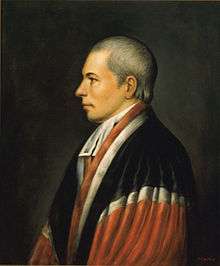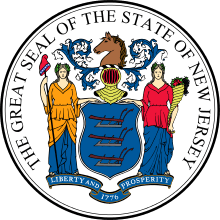William Paterson (judge)
| William Paterson | |
|---|---|
 | |
| Associate Justice of the Supreme Court of the United States | |
|
In office March 4, 1793 – September 8, 1806 | |
| Nominated by | George Washington |
| Preceded by | Thomas Johnson |
| Succeeded by | Henry Livingston |
| 2nd Governor of New Jersey | |
|
In office October 29, 1790 – March 30, 1793 | |
| Preceded by | Elisha Lawrence (Acting) |
| Succeeded by | Thomas Henderson (Acting) |
| United States Senator from New Jersey | |
|
In office March 4, 1789 – November 13, 1790 | |
| Preceded by | Seat established |
| Succeeded by | Philemon Dickinson |
| Attorney General of New Jersey | |
|
In office 1776–1783 | |
| Governor | William Livingston |
| Preceded by | Position established |
| Succeeded by | Joseph Bloomfield |
| Personal details | |
| Born |
December 24, 1745 County Antrim, Ireland (now United Kingdom) |
| Died |
September 9, 1806 (aged 60) Albany, New York, U.S. |
| Political party | Federalist |
| Alma mater | Princeton University |
| Religion | Presbyterianism |
William Paterson (December 24, 1745 – September 9, 1806) was a New Jersey statesman, a signer of the U.S. Constitution, and Associate Justice of the United States Supreme Court, who served as the second governor of New Jersey, from 1790 to 1793.
Early life
William Paterson was born in County Antrim, now in Northern Ireland, moved to what is now the United States at age 2, and entered the College of New Jersey (now Princeton University) at age 14. After graduating, he studied law with the prominent lawyer Richard Stockton and was admitted to the bar in 1768. He also stayed connected to his alma mater and helped found the Cliosophic Society with Aaron Burr.[1]
Career
Early career
Paterson was selected as the Somerset County delegate for the first three provincial congresses of New Jersey, where, as secretary, he recorded the 1776 New Jersey State Constitution. After Independence, Paterson was appointed as the first Attorney General of New Jersey, serving from 1776 to 1783, maintaining law and order and establishing himself as one of the state's most prominent lawyers. He was sent to the 1787 Philadelphia Convention in Philadelphia, Pennsylvania where he proposed the New Jersey Plan for a unicameral legislative body with equal representation from each state. After the Great Compromise (for two legislative bodies: a Senate with equal representation for each state, and a House of Representatives with representation based on population), the Constitution was signed.
United States Senator
Paterson, who was a strong nationalist who supported the Federalist party, went on to become one of New Jersey's first U.S. senators (1789–90). As a member of the Senate Judiciary Committee, he played an important role in drafting the Judiciary Act of 1789 that established the federal court system. The first nine sections of this very important law are in his handwriting.
Governor of New Jersey
In 1790, he became the first person ever to resign from the U.S. Senate, when he did so in order to succeed fellow signer William Livingston as governor of New Jersey. As governor, Paterson pursued his interest in legal matters by codifying the English statutes that had been in force in New Jersey before the Revolution in Laws of the State of New Jersey. He also published a revision of the rules of the chancery and common law courts in Paterson, later adopted by the New Jersey Legislature.
United States Supreme Court
President George Washington nominated Paterson for the Supreme Court of the United States on February 27, 1793, to the seat vacated by Thomas Johnson. Washington withdrew the nomination the following day, having realized that since the Judiciary Act of 1789 (the law creating the Supreme Court) had been passed during Paterson's current term as a Senator, the nomination was a violation of the Ineligibility Clause (Article I, Section 6) of the Constitution. Washington re-nominated Paterson to the Court on March 4, 1793, after his term as Senator had expired; Paterson was immediately confirmed by the Senate and received his commission.
He resigned the governorship to become an associate justice of the U.S. Supreme Court (1793–1806). On circuit he presided over the trials of individuals indicted for treason in the Whiskey Rebellion, a revolt by farmers in western Pennsylvania over the federal excise tax on whiskey, the principal product of their cash crop. Militia sent out by President Washington successfully quelled the uprising, and for the first time the courts had to interpret the provisions of the Constitution with regard to the use of troops in civil disturbances. Here, and in fact throughout his long career, Paterson extolled the primacy of law over governments, a principle embodied in the Constitution he helped write.[2] He was elected a Fellow of the American Academy of Arts and Sciences in 1801.[3]
Death
Paterson served on the Supreme Court until his death (from the lingering effects of a coach accident suffered in 1803 while on circuit court duty in New Jersey) on September 9, 1806, aged 60. He was on his way to the spa at Ballston Springs, New York, to "take the waters", when he died at the Albany, New York home of his daughter, Cornelia Paterson, and son-in-law, Stephen Van Rensselaer (1764–1839). He was laid to rest in the Van Renssalaer family vault in 1806. When the city acquired the property, Paterson's remains were relocated to Albany Rural Cemetery Menands in Albany County, New York. He shares this cemetery with Associate Justice Rufus W. Peckham and President Chester A. Arthur.[4][5][6]
Honors
Both the town of Paterson, New Jersey, and the college, William Paterson University, are named after him.
See also
References
- ↑ "Daily Princetonian Special Class of 1991 Issue 27 July 1987 — Princeton Periodicals". princeton.edu.
- ↑ Wright, Jr., Robert K.; MacGregor, Jr., Morris J. (1987). Soldier-Statesmen of the Constitution. Washington, D.C.: U.S. Army Center of Military History. p. 166. LCCN 87001353. Retrieved July 28, 2014.
- ↑ "Book of Members, 1780–2010: Chapter P" (PDF). American Academy of Arts and Sciences. Retrieved July 28, 2014.
- ↑ William Paterson at Find a Grave.
- ↑ Christensen, George A. (1983) Here Lies the Supreme Court: Gravesites of the Justices, Yearbook at the Wayback Machine (archived September 3, 2005) Supreme Court Historical Society at Internet Archive.
- ↑ See also, Christensen, George A., Here Lies the Supreme Court: Revisited, Journal of Supreme Court History, Volume 33 Issue 1, Pages 17 – 41 (Feb 19, 2008), University of Alabama.
Further reading
- Abraham, Henry J. (1992). Justices and Presidents: A Political History of Appointments to the Supreme Court (3rd ed.). New York: Oxford University Press. ISBN 0-19-506557-3.
- Bibliography on William Patterson at Supreme Court Historical Society.
- Cushman, Clare (2001). The Supreme Court Justices: Illustrated Biographies, 1789–1995 (2nd ed.). (Supreme Court Historical Society, Congressional Quarterly Books). ISBN 1-56802-126-7.
- Flanders, Henry. The Lives and Times of the Chief Justices of the United States Supreme Court. Philadelphia: J. B. Lippincott & Co., 1874 at Google Books.
- Frank, John P. (1995). Friedman, Leon; Israel, Fred L., eds. The Justices of the United States Supreme Court: Their Lives and Major Opinions. Chelsea House Publishers. ISBN 0-7910-1377-4.
- Hall, Kermit L., ed. (1992). The Oxford Companion to the Supreme Court of the United States. New York: Oxford University Press. ISBN 0-19-505835-6.
- Martin, Fenton S.; Goehlert, Robert U. (1990). The U.S. Supreme Court: A Bibliography. Washington, D.C.: Congressional Quarterly Books. ISBN 0-87187-554-3.
- Urofsky, Melvin I. (1994). The Supreme Court Justices: A Biographical Dictionary. New York: Garland Publishing. p. 590. ISBN 0-8153-1176-1.
- Warren, Charles. (1928) The Supreme Court in United States History, 2 vols. at Google books.
- Wright, Robert K.; MacGregor Jr., Morris J. (1987). "William Paterson". Soldier-Statesmen of the Constitution. United States Army Center of Military History. CMH Pub 71-25.
External links
| Wikimedia Commons has media related to William Paterson (judge). |
- United States Congress. "William Paterson (id: P000102)". Biographical Directory of the United States Congress.
- William Paterson at the Biographical Directory of Federal Judges, a public domain publication of the Federal Judicial Center.

- New Jersey Governor William Paterson, National Governors Association
- Oyez Project, U.S. Supreme Court media, William Paterson.
| Legal offices | ||
|---|---|---|
| New office | Attorney General of New Jersey 1776–1783 |
Succeeded by Joseph Bloomfield |
| Preceded by Thomas Johnson |
Associate Justice of the Supreme Court of the United States 1793–1806 |
Succeeded by Henry Livingston |
| United States Senate | ||
| New seat | United States Senator (Class 2) from New Jersey 1789–1790 Served alongside: Jonathan Elmer |
Succeeded by Philemon Dickinson |
| Political offices | ||
| Preceded by Elisha Lawrence Acting |
Governor of New Jersey 1790–1793 |
Succeeded by Thomas Henderson Acting |
| | |||||||||||||||||||||||||||||||||||
|---|---|---|---|---|---|---|---|---|---|---|---|---|---|---|---|---|---|---|---|---|---|---|---|---|---|---|---|---|---|---|---|---|---|---|---|
|
 | ||||||||||||||||||||||||||||||||||



